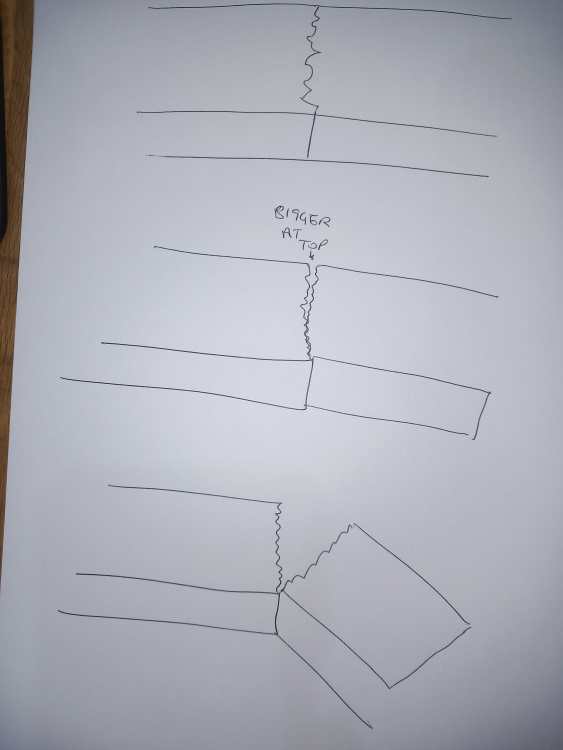-
Posts
2352 -
Joined
-
Last visited
-
Days Won
3
Everything posted by Marvin
-

Surge protection, fuses and MCBs in loft from PV array.
Marvin replied to jimseng's topic in Photovoltaics (PV)
I used SWA. The energy can go both directions remember... -
When I did our side extension flat roof connection to the eves side of the bungalow I used OSB vertically all the way up, in between the roof joists, sealed the gaps with mastic and then put plastic over the OSB and sealed the edges where necessary before insulating, to protect the void. When PIR insulating I foamed every gap that was between any timber and the PIR.
- 14 replies
-
- insulation
- posi-joists
-
(and 2 more)
Tagged with:
-
Always Terram down first in my book. Temporary surface on top is a discussion depending on the site size and use.
-

So to today's questions on our ASHP install.
Marvin replied to MikeSharp01's topic in General Plumbing
One expansion vessel for the primary water circuit which connects the ASHP to the coil in tank and heating system. -

So to today's questions on our ASHP install.
Marvin replied to MikeSharp01's topic in General Plumbing
MVHR unit will trickle water when the outside temperature is lower than the inside temperature but doesn't need a tundish. It is meant to drip. Tundishes enable you to see that there is a fault because it is dripping. My MVHR has a waterless trap which runs through 22mm plastic to a waste pipe connection. The hot water to the tundish needs to be as the regulations show: max of two 15mm connected at the top. 22mm below copper all the way. -

So to today's questions on our ASHP install.
Marvin replied to MikeSharp01's topic in General Plumbing
Easy one first: 3: https://www.bes.co.uk/push-fit-overflow-reducer-from-waste-32-x-215mm-11244/ -
Hi @Spinny Simple tests you can carry out: If the expansion tank is connected uninhibited to the hot water pipe I would turn the cold water supply to the tank off run a tap until there is no pressure in the hot. make sure no one uses the hot water for say an hour. then turn hot tap on. What is the result? If there is no pressure then the problem is related to the cold water. However if there is pressure it could mean there is a problem with the hot water OR the cold water.(some taps will allow water to pass from one to the other supply when pressures are greatly different even when off - perhaps I use too cheaper taps 😂) Turn the cold water supply to the house off this time. do the same to the cold water. If there is no pressure then the problem is related to the hot water. However if there is pressure it could mean there is a problem with the hot water OR the cold water. Good luck
-
Hi @Spinny Lots of alternatives here for you to consider... You said a lot when you wrote that the drips in the tundish were cold in my opinion. I would have questioned if the cold water pressure reducing valve (PRV) is working correctly. If you needed a water softener it suggests that the water is hard and this can cause limescale buildup. If the hot water is under a lot of pressure when first turned on but when left to run reduces in pressure and slowly increases when shut off again it suggests the PRV is letting a small amount of water pass through all the time. Sometimes water pressure can run out of the cold and into the hot when a tap is turned on so I think both having high pressure should be ignored at this point. What you need to do is have the softener installed for sure. It must have been planned for a reason... As for the expansion tank. If it is set at 3 bar, then anything below will not fill the expansion tank, anything above will start to fill the expansion tank. I hope this helps Good luck M
-
Hi @DownSouth Sorry to hear about the problem. Would you please indicate where the water is coming through. Is it in any particular area? What you have is a sort of pond with drains at the bottom. It concerns me that the drains could become blocked with the leaves and the water rise above the sides of the fibreglass when there is torrential rain. More info = better understanding = better advice
-
Hi @lookseehear For me it would depend on the how shaded the panels are, the pitch of the roof and if the panels will face due south because I am more interested in how much energy is produced during the winter months. This is because winter is the time when the system produces about one fifth of the energy compared with the summer and we use about 5 times the energy heating the house. My assumption is using "packages" from energy suppliers which give you lower and higher rates at different times will slowly change to different periods of the year as well. I know in some other countries that, as more and more people have PV, the power generated during more and more days in the summer has become almost worthless because more is being produced than used. This "changing the game" or "moving the goal posts" means long term that anything that is in someone else's control will change as has happened with Electric Vehicles (EV): The benefits of having an EV have diminished so far that it now makes little financial difference. The breakthrough will be when the energy can be stored long term in a cost effective manner when the more PV you have the better off you will be. If you have more than I think, a 3.6 kWh system, you have to obtain permission from your power supplier.
-
Yup. As they say The Devil is in the detail!
-

Is the party over (pt2) - End of high fixed price export tariffs?
Marvin replied to -rick-'s topic in Photovoltaics (PV)
Yup. Nothing that is not in your control is in your control and things that are in your control will soon not be. -

Looks like the party is over....
Marvin replied to Beelbeebub's topic in Air Source Heat Pumps (ASHP)
Worse than that we spent more than we had whilst selling the countries inheritance! Now going forward we will inherit just a debt... -
I assume you have stopped the leak. If so how bad was it for how long? It's important to know this. The ends of the boards look as if they are damp which means that the water may have run under the boards, and may have gone some distance.
-

Fixing ASHP Anti Vibration Feet
Marvin replied to BadgerBadger's topic in Air Source Heat Pumps (ASHP)
Our ASHP is on the flat roof completely exposed - over 100 mile an hour winds - 600mm long rubber feet - no movement so far after 4 years. -
Hi @damspt £490??? That would be impressive! f If I remember correctly my my ASHP uses about 30 watts per hour on standby. So 30 watts times 24 hours times 365 days is .. er 262 kWh per year. Hot water say 2kWh per day is 730 kWh. All other electrical equipment is not included in the EPC calculation. So 262 plus 730 is 994 times average 25pence per kWh is £248 per year Standing charge 19p per day say £70 Lighting - 6 5 Watt bulbs 10 hours per day £11kWh - say £30 Total £348 Plus VAT 17.40 £365 electricity bill with no heating! So about £130 for the heating per year after VAT.
-
Hi @damspt It's usually on the bit that says this: (an example) How this affects your energy bills An average household would need to spend £836 per year on heating, hot water and lighting in this property. These costs usually make up the majority of your energy bills. You could save £224 per year if you complete the suggested steps for improving this property’s energy rating. This is based on average costs in 2025 when this EPC was created. People living at the property may use different amounts of energy for heating, hot water and lighting. Heating this property Estimated energy needed in this property is: 7,062 kWh per year for heating 2,688 kWh per year for hot water
-
Hi @damspt There are so many considerations when discussing ASHPs. Although I am not a fan of EPC's I would be interested to know what rating your house is. If you look up your home on the EPC register it will tell you lots of things which are questions you would be asked here. For example: Is your home rated A B or C. The Floor area and the calculated kWh use per year for heating: If you divide the kWh by the floor area this will give you the amount of heating in kWhs per square metre floor area per year. From my own experience with our ASHP over the last few years we are satisfied with the results. Our ASHP uses masses during cold weather but almost nothing during the rest of the time. We run at about 22 - 23 degrees C during the winter. We also have a MVHR system and PV. So when you compare our little bungalow to @Nickfromwales's home we would use kWh per year per square metre of floor. (don't do it Nick you would only be depressed😆). Good luck M
-
A rather poor drawing of what has happened so far and what could happen.. Note the gap at the top wider than at the bottom. Extreme drawing I know but you see how it falls and why the crack is bigger at the top and at this stage not visable at the bottom because it has not gone that far yet.
-
Hi @kyran It looks like the wall on the right hand side of the crack is dropping going away from the left hand side. Yes the RSJ on the pad stone is pushing down, but the foundations holding up the RSJ wall appear not to be capable of holding up the load. Also it looks like the crack is where 2 different walls have met, presumably the foundations below each part of the wall are different. You may also want to clarify how much this house insurance would cost. Also what caused the previous subsidence. Was it a drain or roots or quality of the foundations or the soil. You can pay a high insurance premium for a building that has had subsidence for 20 years!
-
Hi @JohnMo Yes, need good insulation in narrow space so using PIR. Studs existing. breather on outside. True still thinking about 25mm PIR on inside.
-
Hi @Redbeard thanks for this Yes on the inside I am adding 25mm over the joists, then the VCL then the Fireboard. Forgot to say this is for a garden room walls. Hi @Mr Punter Thanks for the info.
-
Thanks @JohnMo I was also thinking about the dew point. I didn't know which way was best to instal them PIR to the outside and glass wool inside or vice versa.
-
I have a timber frame that I want insulate which varies in thickness from about 118mm to 155mm I was thinking of using 100mm PIR and loft insulation to fill the gap. Which is best: Outside surface, 100 PIR loft insulation Inside surface. or Outside surface loft insulation, 100 PIR inside surface.




